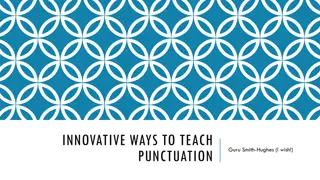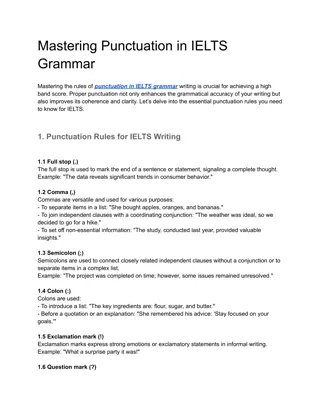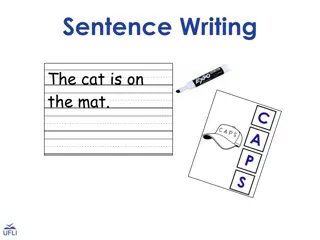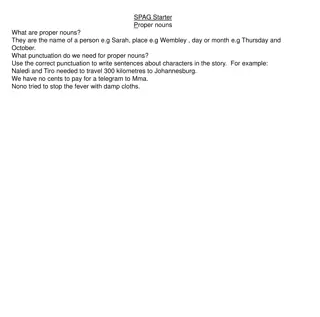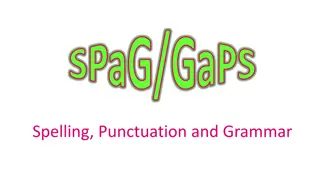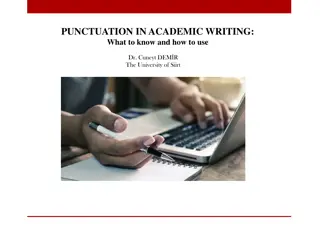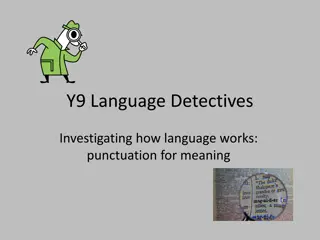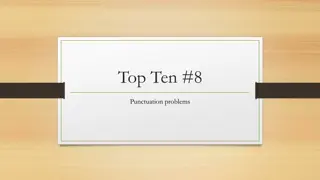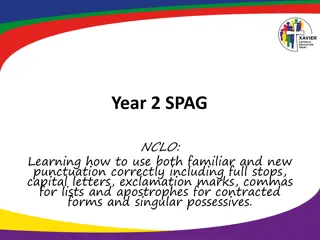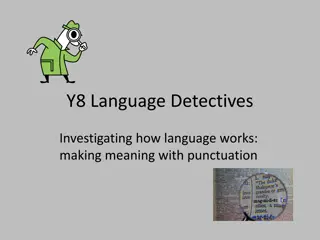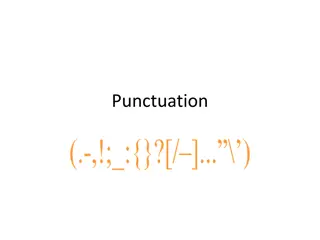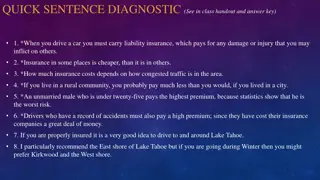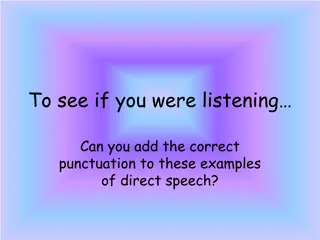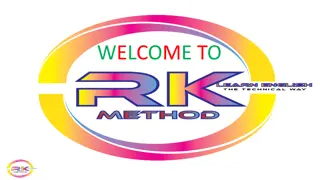Mastering Punctuation Rules in English Writing
Explore essential punctuation rules in American English writing, including correct comma usage with conjunctions, introductory clauses, and compound adjectives. Learn to enhance readability and accuracy in your writing by understanding when and how to use commas, semicolons, colons, and hyphens effectively.
Download Presentation

Please find below an Image/Link to download the presentation.
The content on the website is provided AS IS for your information and personal use only. It may not be sold, licensed, or shared on other websites without obtaining consent from the author. Download presentation by click this link. If you encounter any issues during the download, it is possible that the publisher has removed the file from their server.
E N D
Presentation Transcript
Punctuation John Brocato john.brocato@uga.edu @CMB_Engineering
Heres what well discuss today: Commas Semicolons Colons Hyphens with compound adjectives Miscellaneous issues @CMB_Engineering
Notes: Not all punctuation rules are strict; some are situational or open to interpretation. Always use resources (handbooks, these slides, the Purdue OWL) when you write; avoid relying on memory. The rules we discuss herein are based on American English; British English can be quite different. @CMB_Engineering
Commas Always provide a comma with two independent clauses and a conjunction. The liquid that is collected at the bottom of the column is piped to a heat exchanger Complete sentence and Conjunction (also but, so, et al.) some of the collected liquid is vaporized to reenter the column so that the process can be repeated. Complete sentence @CMB_Engineering
Commas Always provide a comma with two independent clauses and a conjunction. The liquid that is collected at the bottom of the column is piped to a heat exchanger, and some of the collected liquid is vaporized to reenter the column so that the process can be repeated. Omitting this comma is common and often causes no major problems, but including it is never wrong and increases readability. @CMB_Engineering
Commas Do not include a comma when the clause that comes after the conjunction is dependent (i.e., it has no subject). INCORRECT: The process of wastewater treatment is unfamiliar to many people, but is essential to everyday life. @CMB_Engineering
Commas Always provide a comma between introductory dependent clauses and main clauses. While flowing through the aeration basins Dependent clause/incomplete sentence the water is stripped of carbon dioxide and other compounds. Main clause/complete sentence @CMB_Engineering
Commas Always provide a comma between introductory dependent clauses and main clauses. While flowing through the aeration basins, the water is stripped of carbon dioxide and other compounds. Omitting this comma is common and often causes no major problems, but including it is never wrong and can avoid misreading, as below. Pause or read straight through? To begin a geological survey must be taken to determine the best route for the road to take. @CMB_Engineering
Commas Always provide a comma between introductory dependent clauses and main clauses. While flowing through the aeration basins, the water is stripped of carbon dioxide and other compounds. Omitting this comma is common and often causes no major problems, but including it is never wrong and can avoid misreading, as below. Pause. To begin, a geological survey must be taken to determine the best route for the road to take. @CMB_Engineering
Commas Always provide the terminal or Oxford comma in a series of three or more items. The terminal comma comes just before the and in a series: I like green, brown, and orange. Though omitting this comma can be harmless, providing it is never wrong and can increase readability. CONFUSING: The elbow system consists of a short section of aluminum tubing that attaches to a prosthetic hand, a cog and wedge at the elbow joint and another section of tubing that attaches to the shoulder. @CMB_Engineering
Commas Because the first item (a short section ) is relatively long, and because the second item (a cog and wedge at the elbow joint) already contains an and, readers might be confused by two close uses of and without a comma to signal where the second item ends and the third begins. CLEARER: The elbow system consists of a short section of aluminum tubing that attaches to a prosthetic hand, a cog and wedge at the elbow joint, and another section of tubing that attaches to the shoulder. @CMB_Engineering
Commas Do not provide a comma with only two items joined by and. INCORRECT: Roy s software proficiencies include SolidWorks, and AutoCAD. @CMB_Engineering
Commas Never join two independent clauses with only a comma (comma splice). Comma splices are considered to be major mechanical errors. They consist of two independent clauses joined only with a comma. INCORRECT: At this eight-mile marker, the first of the final burns takes place, this is known as the terminal intercept (Ti) burn. Two independent clauses, no conjunction, comma @CMB_Engineering
Commas Several possible revisions exist for this error; the easiest one would be to replace the comma with a semicolon (or period). CORRECT: At this eight-mile marker, the first of the final burns takes place; this is known as the terminal intercept (Ti) burn. @CMB_Engineering
Commas Transition words like however and therefore still create comma splices if they are preceded only by a comma. INCORRECT: Exhaust systems do not create power, however a less restrictive exhaust can take away less power from the motor. Two independent clauses, transition word, comma CORRECT: Exhaust systems do not create power. However, a less restrictive exhaust can take away less power from the motor. @CMB_Engineering
Semicolons In written body text, semicolons are primarily used for two reasons: (1) To join independent clauses that are closely related in some substantive way: The initial costs of such a system are high, often $800,000 or more; however, some companies have seen a full return on investment in fewer than 18 months. @CMB_Engineering
Semicolons (2) To separate three or more items in series that are relatively lengthy and/or already contain commas: The general equipment for this process includes a tank to hold the mixture; a pump to pump the mixture into the tank; a heater to heat the mixture to a boiling temperature; a distillation column to allow the travel of water vapor from the tank; a condenser to cool the water vapor so that it turns into a liquid; and a second tank to capture the liquid. @CMB_Engineering
Semicolons Any other usage is probably incorrect. INCORRECT: The field of scaled model testing allows engineers to create safer, more advanced products more quickly and with less expense; a result which provides the consumer with a better product at a better price. Comma, colon, or dash INCORRECT: Chemical composition refers to a breakdown of the substances in the stream; for instance, 10% water, 50% oxygen, 40% titanium. Colon or dash @CMB_Engineering
Semicolons Any other usage is probably incorrect. INCORRECT: The amount of a substance that goes in a reactor; must yield a product or products that equals that same amount. Omit INCORRECT: While every wing and airfoil shape has its own set of advantages and disadvantages; the correct combination can be used with very effective results. Comma @CMB_Engineering
Colons In written body text, colons are primarily used for four reasons: (1) To introduce a list after an independent clause: Complete the thought avoid putting the colon just after the verb This report discusses the following major points: (a) the history of NASA's space program; (b) the environment of NASA at the time of the disaster; (c) the technical flaws that caused the destruction of the Space Shuttle Columbia; (d) the investigations and hearings of the disaster @CMB_Engineering
Colons (2) To introduce a quotation after an independent clause: Cheney suggests that laboratories should foster global teamwork: "Think of the impact on biomedical research if individual labs would create their own online database of commonly prototyped enzymes; the access afforded to other, perhaps less affluent facilities would be unprecedented" [5]. @CMB_Engineering
Colons (3) To introduce an example or further illustrate the point of an independent clause: Chemical composition refers to a breakdown of the substances in the stream: for instance, 10% water, 50% oxygen, 40% titanium. @CMB_Engineering
Colons (4) To emphasize the second of two independent clauses: The loss of Space Shuttle Challenger was hardly an accident: indeed, the very design flaw that caused its destruction had been openly and, in some cases, emphatically discussed for 8 years prior to the disaster. You can make a case for a semicolon here instead. @CMB_Engineering
Hyphens with Compound Adjectives When two or more adjectives precede and modify a noun equally, those adjectives must be hyphenated. on-the-job injuries flight-critical components 500-grit dry sand paper 9-volt battery manufacturing-related incidents large-scale software development 8-foot-long, half-credit-card-thick nozzle extension air-to-fuel ratio helicopter-like rotor five-step process clay-filled tray forty-five-degree swept angle @CMB_Engineering
Hyphens with Compound Adjectives Although omitting these hyphens may sometimes be harmless (especially with familiar phrases), their absence can be confusing. CONFUSING: A key distress mode used in analyzing turbine blade material performance and life is surface roughness. Are these different? Is this even important? Turbine-blade material performance? Turbine blade-material performance? Turbine-blade-material performance? Let your audience know. @CMB_Engineering
Hyphens with Compound Adjectives CONFUSING: Small network appliance platforms such as routers fall in this broad category. This example has the same problem: Small network-appliance platforms? Small-network appliance platforms? Small-network-appliance platforms? Are these different? Is this even important? Let your audience know. @CMB_Engineering
Miscellaneous Issues The correct order for punctuating quotations is 1. Last quoted word 1. Last quoted word OR 2. Period 2. Closing quotation 3. Closing quotation mark mark 3. Citation 4. Period @CMB_Engineering
Miscellaneous Issues According to Al McDonald, For each day the Shuttle was out of flight status, it was costing NASA over $10 million or $4 billion a year [6]. Without a citation, other punctuation marks appear outside the closing quotation mark unless they re part of the original quote. Commas always go inside the closing quotation mark. @CMB_Engineering
Miscellaneous Issues Use periods with vertical list items that form complete sentences; otherwise, use no punctuation at all. This report discusses the following major points: (a) the history of NASA's space program (b) the environment of NASA at the time of the disaster (c) the technical flaws that caused the destruction of the Space Shuttle Columbia (d) the investigations and hearings of the disaster (e) the socio-economic consequences resulting directly from the disaster (f) the disaster s impact on future space programs @CMB_Engineering
Punctuation John Brocato john.brocato@uga.edu @CMB_Engineering


